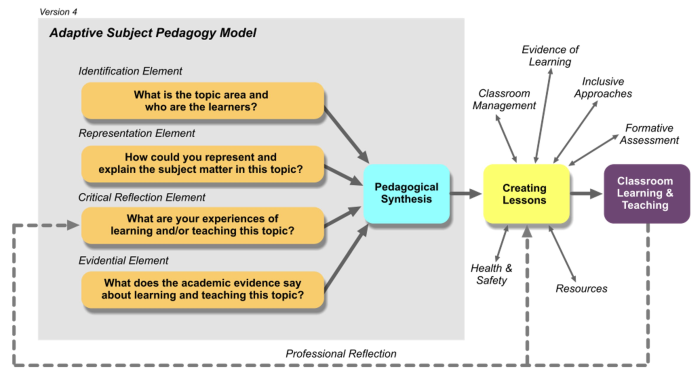UGEAN Emerging thinking
Supporting student teachers to create evidence-informed pedagogies: creating the Adaptive Subject Pedagogy Model
Project Members: David Morrison-Love & Fiona Patrick
Section 1: Background
Arising directly from work in teacher education and assessment, Morrison-Love developed the adaptive subject pedagogy model (ASPM) to address a number of challenges in how ITE students develop pedagogical expertise and inform their thinking with evidence. We were concerned that the approaches we were taking to curriculum, assessment and pedagogy did not support students to meaningfully integrate different forms of knowledge from across their degree programme. Many students performed well in terms of grades for individual programme courses, but this did not mean that they could integrate learning from these academic courses into their classroom practice while on school experience.
We believe that effective teacher education needs to enable students to critically synthesise theory, research, and practice together with a range of different forms of knowledge if students are to create evidence-informed and thoughtful classroom learning. This requires us to move beyond ideas of simply ‘bridging’ the ‘theory-practice gap’, and away from overly instrumental thinking and assumptions about content, pedagogy, and assessment that seem to us to encourage orthodox lesson planning approaches rather than creative and innovative approaches to teaching and learning informed by research and theory.
The ASPM is designed to scaffold student planning for learning that is evidence-informed, reflective, and considered. Findings from our research show that students are now developing more sophisticated pedagogical reasoning with significant potential for classroom practice and pupil learning.
Section 2: Description of the ASPM
The Adaptive Subject Pedagogy Model was first developed in 2018 by David Morrison-Love. It has since been refined, with Fiona Patrick, through work with their students, and Version 4 of the ASPM is shown in Figure 1. Importantly, the ASPM is not about ‘lesson planning’. Rather, it is a model for integrating different forms of knowledge to generate subject-specific pedagogies within a specific curriculum area from which a unit of learning and teaching is created. It has its basis in the work of Lee Shulman and draws upon theoretical and empirical understanding from content and pedagogical knowledge for teaching, reflective practice, learning progression and transformation.

The ASPM is purposefully driven by considerations of what is to be taught, who is to be taught, and who will be teaching. It has four key elements: (i) an identification element, (ii) a representation element, (iii) a critical reflection element, and (iv) an evidential element. In the first of these, students identify a topic area. In the second, they map out and represent the different elements of subject matter involved which can include skills, concepts, dependencies and so forth. In the third element, students critically reflect on their own experience as a learner and/or teacher of the topic and consider the learners who they will be teaching; and, in the fourth element, they identify key findings from published research/theory about learning and teaching in their chosen topic. What students learn from all four of these elements is then synthesised to inform the creation of their own pedagogical proposal for teaching the topic. In this process of critical synthesis evidence from reflection is no more or less important than evidence from published research. This principle is important if students are to create pedagogical approaches that embody something of who they are becoming as teachers.
Section 3: Emerging Thinking & Implications
Through work with students on the ASPM, Morrison-Love and Patrick are thinking in particular about the following aspects:
- The complexities of integrating knowledges and synthesising understandings to underpin classroom teaching and learning. How do we best support beginning teachers with this complexity?
- How do we move from generic linear lesson plans that present content, learning and assessment as disaggregated elements rather than as an integrated and holistic pedagogic proposal?
- How do we create spaces on our teacher education courses and beyond for critical thinking and learning about what knowledges matter for teacher education?
Section 4: Publications, Links & Resources
Figure: The Adaptive Subject Pedagogy Model, Version 4. (1st November 2021) https://doi.org/10.6084/m9.figshare.16912948.v1
Blog Article: Rethinking our Approach to Teacher Education(18th October 2021). https://doi.org/10.6084/m9.figshare.16917505.v1
Presentation: Empowering Student Teachers to Create their own Pedagogy using the Adaptive Subject Pedagogy Model (5th October 2021) https://doi.org/10.6084/m9.figshare.16912957.v1
Podcast: Talking Pedagogy and Theory with David Morrison-Love (4th October 2021) https://doi.org/10.6084/m9.figshare.16917493.v1
Conference Presentation: The Adaptive Subject Pedagogy Model: Empowering Student Teachers of Design & Technology Education to Create their own Pedagogy. (28th April 2021) https://doi.org/10.6084/m9.figshare.16912867.v1
Conference Presentation: Integrating Knowledge for the Creation of Subject Pedagogies: An Adaptive Subject Pedagogy Model for ITE in Design & Technology. (22nd November 2019) https://doi.org/10.6084/m9.figshare.16912915.v1
Presentation: Integrating Knowledge for the Creation of Subject Pedagogies: An Adaptive Subject Pedagogy Model for ITE in Design & Technology (25th June 2019) https://doi.org/10.6084/m9.figshare.16912915.v2

